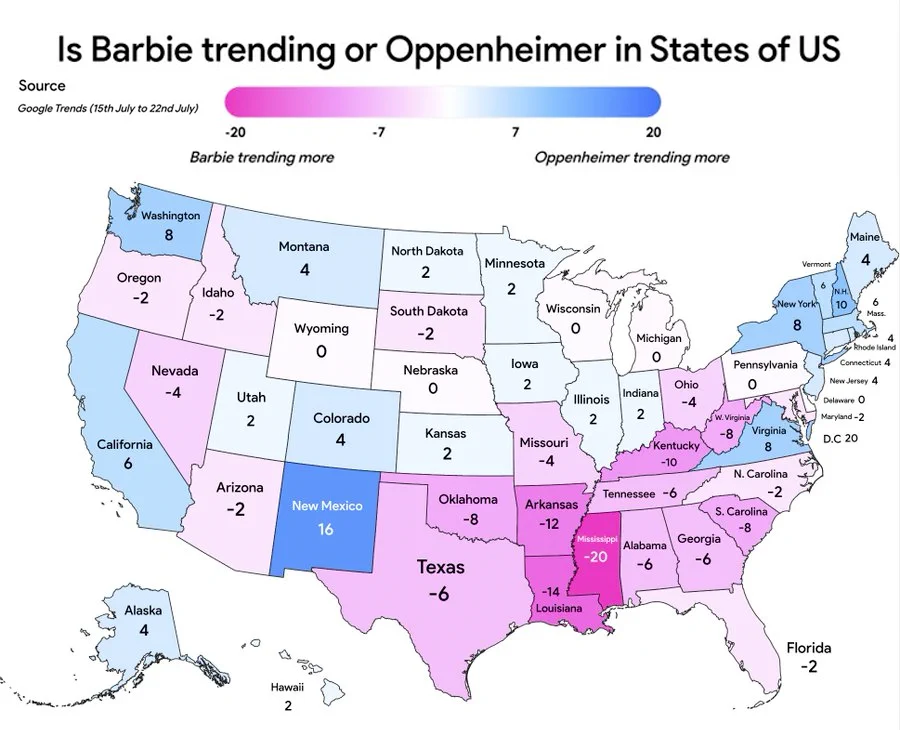The “Barbie” and “Oppenheimer” movies were certainly the iconic duo of the summer.
Both blockbusters were met with smashing success, generating a combined $235.5 million in ticket sales on opening weekend. Following the weekend, a viral X (formerly known as Twitter) post displayed the popularity of each movie in U.S. states.
Interestingly, the graphic looks very similar to the 2020 electoral map. The map shows Barbie trending more in Republican states, while Oppenheimer was more popular in Democratic states. Even the swing states of Wisconsin, Michigan, and Pennsylvania were evenly divided between the two blockbusters.
To me, this was fascinating. Why would Barbie, a movie accused by conservatives of being too “woke” and “feminist,” be so popular in the South? Why does a movie about the inventor of the atomic bomb appeal to liberals with more anti-nuclear proliferation stances?
First, we have to consider that the Barbie doll, for many, has long been a symbol of traditional gender roles and femininity. Barbie is simple and apolitical. She is content with her life and focused on happiness. For many, her perfect lifestyle is an escape from the complexity of real life. Her image is the epitome of a perfect America.
But is this the image that people saw when they went to see the movie? Did it celebrate a perfect America?
No. The movie itself disrupts these stereotypes, presenting a new face for Barbie. It depicts her growing awareness of the flaws in society. She emerges from her perfect pink universe into the real world. She is confronted with the negative aspects of her image, particularly her perpetuation of unrealistic beauty standards. Meanwhile, when the Kens travel to the real world, they realize that there is political power in gender. Barbie has to fight to assert that the direction of society should be guided by what is right and not gender.
So, while conservatives may have watched “Barbie” expecting to see a simple depiction of America, the movie actually challenged traditional beliefs. In fact, conservative commentator Ben Shapiro, in a YouTube video, called it “one of the most woke movies I have ever seen,” claiming its intended audience was unclear.
Conservatives may have missed the point of the movie. It is not the movie version of “Barbie: Life in the Dreamhouse.” It is a social commentary meant to take a satirical attitude about gender roles and traditional femininity. Perhaps the marketing of the movie failed to adequately emphasize that it was not a cartoon aimed at children but a response to society’s criticism of Barbie.
On the “Oppenheimer” side, it’s clear why some states favored the movie. New Mexico, for instance, the state with the highest percentage of Oppenheimer viewers, was the location for the Manhattan Project testing. The movie is a depiction of New Mexico’s own history and global impact, which drew in many viewers.
But for other states, it’s a little less obvious. Is “Oppenheimer” intended for more Democratic audiences? The movie does take a more left-wing stance on America’s past. “Oppenheimer” doesn’t shy away from opening debate about the U.S.’s bombing of the Japanese. This film certainly takes an anti-jingoist view, questioning the U.S.’s aggressive foreign policy during the Cold War.
But, like with “Barbie,” did Democrats see the movie they were expecting?
They may have expected to see a movie about Oppenheimer as a martyr of the McCarthyism era. He was suspected of being a Soviet spy despite his tremendous contribution to the war effort in America. However, Oppenheimer’s portrayal wasn’t as clear-cut as the audience might have expected. He was depicted as arrogantly entitled because of his genius. The movie exposes his flaws and doesn’t paint him as a perfect figure.
Audiences for both movies might have expected a simple depiction of both Barbie and Oppenheimer. However, the film they actually saw presented both characters in a more complex way. Barbie isn’t just a girly doll; Oppenheimer isn’t just a martyr hero scientist. The electoral map of “Barbenheimer” may have captured viewers’ expectations of both movies, but not the true nature of them. Instead, it captured the political values of America, showing the division between traditional values and progressive ones.












